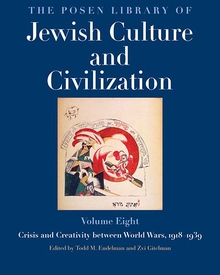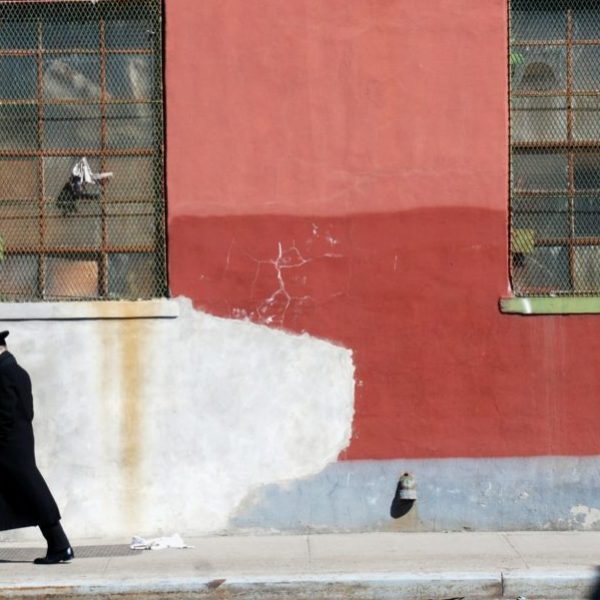Jewish Life during the Interwar Period
Todd M. Endelman and Zvi Gitelman—
The new states that emerged in Europe and the Middle East from the collapsed German, Austro-Hungarian, Russian, and Ottoman empires were insecure, fearing their neighbors and their demands to change the borders created by the treaties ending World War I. They were suspicious of ethnic and religious minorities in their midst, including the Jews. With some exceptions, these states embittered Jews’ lives in large and small ways. The collapse of the world economy in 1931, triggered by the earlier crash of the stock market in the United States, posed its own threats. One consequence was the continuing immiseration of the Polish Jewish community, the largest in Europe.
The suffering and insecurity of the Jews of Europe (and, to a lesser extent, the Middle East and North Africa) echoed in more secure parts of the Jewish diaspora, especially in the United States. North American Jewry, while not spared discrimination and stigmatization at home, rallied to provide material relief to the stricken communities of East Central Europe and slowly emerged as the richest and most influential Jewish community in the world. But with the passage of restrictive immigration laws in the early 1920s, the United States no longer served as a refuge for European Jews fleeing poverty and persecution. Indeed, as the Jews of Germany, Austria, and Czechoslovakia learned after the rise of Nazism, there were no longer any countries in the world that welcomed Jewish refugees.
Rapid, dramatic change characterized the short twenty-year interval between the two world wars (1918–1939). In Europe, economic crises after 1929, strident nationalist movements and militant radical parties, political polarization and the erosion of liberalism, and the slide from democratic to authoritarian norms undermined Jewish hopes for stability and security, especially in the new states that emerged in Eastern and Central Europe. In West European societies and in North America, the challenges were less dire but daunting nonetheless. However, despite the economic downturn of the 1930s, Western Jews (both native born and immigrants) continued to move into the middle class. In the United States, the Jewish community emerged as a significant influence in American and world Jewish politics. In Palestine, then under British control, the Jewish population grew rapidly, becoming more ideological and secular. If the fewer than 10 percent of European Jews who lived in Western democracies in the 1930s felt a sense of unease, then in Poland, Romania, Hungary, and Germany there was a palpable feeling of impending trouble, if not catastrophe. Aaron Zeitlin, a Polish Jew who published in Yiddish and Hebrew, sounded this alarm already in 1932, and by the end of the decade, a wide variety of writers—religious, secular, Zionist—did so as well.
Only in the Soviet Union, where “socialism was being built,” did the government generate optimism and hope. In the late 1920s and the 1930s, large numbers of young people enthusiastically migrated to the Urals, Siberia, and other undeveloped areas to build cities and factories, break virgin soil, and try to propel the Soviet Union forward at breakneck speed, with tempos dictated by official “five-year plans.” These efforts, which involved an explicit break with the past, were applauded in Soviet music, art, and literature, including in Yiddish works.
Before World War I, the Russian Empire had the largest concentration of Jews in the world, about 5.2 million. There were about 2.2 million Jews in the Austro-Hungarian (Habsburg) Empire. In 1918, the Jews in these empires became citizens of new or reconstituted states—the Baltic states, Czechoslovakia, Poland, Romania, Yugoslavia, Hungary, and what became the Soviet Union. Traditional trade patterns were disrupted; new political loyalties and, often, languages, had to be learned; and new ethnic policies confronted.
In the multilateral wars that occurred during and immediately after World War I, Jews were forced to choose between rival nations fighting for territory and sovereignty: Russians and Poles; Lithuanians, Russians, and Poles; Hungarians and Romanians; Germans and Czechs. Everywhere Jewish loyalty was suspect. The prominence of Jews in the early Bolshevik regime in Soviet Russia and their dominance in the short-lived communist regime in Hungary (1919) raised the specter of a communist–Jewish conspiracy to take over the world, despite the fact that nominally Jewish communists were disconnected from Jewish culture, let alone Judaism. Known as the Zydokomuna idea, the “Jewish-communist conspiracy” became an important element in domestic and foreign politics in nearly all countries of the region and was widely believed elsewhere.
The insecurity of the states created by the postwar peace treaties resulted in part from their neighbors’ refusal to acknowledge their legitimacy. This was the case with newly created Czechoslovakia and Yugoslavia. Many borders were disputed: Romania–Hungary, Poland–Lithuania, Poland–Soviet Union, Germany–Czechoslovakia, and Bulgaria–Yugoslavia. The threat of subversion made majority nations suspicious of national and religious minorities, including the Jews, living within their borders. All states in the region, with the exception of Czechoslovakia, failed to sustain the democratic systems and nationality rights to which they had been pledged. They became “ethnic states,” whose purpose was to serve the interests of one dominant nation, rather than “civic states,” whose citizens were integrated around political ideas rather than ethnicity or religion. The Soviet Union was exceptional in this regard, as it stood for “proletarian internationalism,” but it was no democracy, and as its critics on the left pointed out, it became less of a “workers’ state” and more a bureaucratic dictatorship. By the mid-1930s, significant fascist movements emerged in all of Europe, spurred on by Germany and Italy, which shared an interest with Hungary in revising the Versailles treaties. Even in the United States, there were vociferous pro-Nazi, antisemitic groups, as there were in Latin America. In the Middle East, some Arab leaders aligned themselves with Nazi Germany.
Worldwide economic depression in the 1930s fed a desire for radical solutions. Communist atheism and “internationalism,” foundational values of the Soviet state, were abhorrent to the largely peasant, religious, and nationalistic populations of Eastern Europe. They were even more alienated by the Soviet collectivization of agriculture and forced rapid industrialization that were introduced in 1928. Fascism, invoking mythologized glorious national pasts and even more glorious futures, and committed to antisemitism and treaty revision, appealed especially to the unemployed, déclassé, and desperate. Conservative regimes felt as threatened by right radicalism as democratic ones, and both adjusted their foreign and domestic policies to head off right-wing revolutions.
Political unrest and violence roiled Germany, Austria, and Hungary, which had been allies during World War I, in the immediate postwar period. In 1922, Hungary passed a numerus clausus law restricting the number of Jews in higher education. A communist uprising was put down quickly in Germany, but the communist regime in Hungary, in which persons of Jewish origin were prominent, lasted more than four months and traumatized many Hungarians, instilling a deep fear of communism. In the 1930s, successive anti-Jewish laws were passed, but most Hungarian Jews, like their German coreligionists, remained highly patriotic.
For nonreligious and non-Zionist Jews in the late 1930s, the Soviet Union seemed to offer some relief from political instability, economic crisis, and social discrimination. True, it vigorously suppressed Judaism, Zionism, and Hebrew culture, but its Jews enjoyed unparalleled social and political mobility. They suffered no official restrictions, unlike in Poland, Hungary, and Romania, and were visible among the Soviet elite. In contrast, Polish Jewry, numbering some 3,350,000, was increasingly impoverished and discriminated against. It was internally divided into quarreling factions and unable to unite against antisemitism. The anti-Zionist, ultra-Orthodox political party Agudas Yisroel, for example, supported even antisemitic governments in return for their certifying that its religious schools fulfilled the demands of the compulsory-education law. Emigration, once a prominent solution to desperate situations, was nearly impossible, as in 1924 the United States had closed its doors to East European immigration, and the British imposed increasingly severe restrictions on immigration to Palestine.
Even without hindsight, the end of the interwar period loomed ominously for all of Europe, and especially for its Jews.
From The Posen Library of Jewish Culture and Civilization, Volume 8 edited by Todd M. Endelman and Zvi Gitelman. Published by Yale University Press in 2020. Reproduced with permission.
Todd M. Endelman is Professor Emeritus of History and Judaic Studies at the University of Michigan. Zvi Gitelman is Tisch Professor of Judaic Studies Emeritus and Professor Emeritus of Political Science at the University of Michigan.
Further Reading:



























